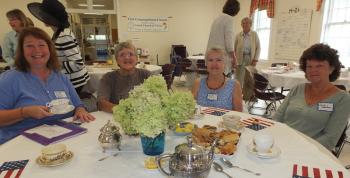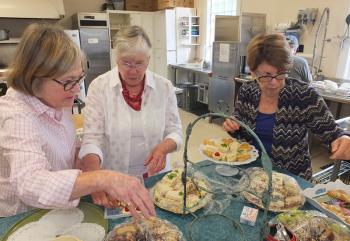CAMDEN – "The greatest mark of civility they can show you is to invite you to drink tea with them." And so began Mary Kay Fenton, as she addressed the Camden Garden Club on the subject of tea. Tea was the social beverage of the 18th Century. The plant itself was an established commodity, and the drinking of it was a social custom.
"It was a practice complete with it's own set of prescribed behaviors, etiquette and utensils," said Fenton. "To understanding all this, better helps us to interpret American history, to recreate period interiors for museums and to bring 18th-Century life into clearer focus."
Fenton said tea then was the social beverage. The dried plant itself was an important commodity, but the drinking teas was an established social custom with its own set of prescribed behaviors, etiquette and utensils.
"Before the American Colonies were established tea was used in the Far East," Fenton said. "The first recorded tea drinking occurred in China in the 10th Century BC."
Tea was exported to Korea and Japan. Tea was imported to Europe during the Portuguese expansion. Tea was introduced to court in England around 1660.
The common man first encountered tea in coffee houses, along with chocolate from the Americas and coffee from the Near East.
Early tea was advertised as making the body active and lusty. It also was touted as preserving health until extreme old age. Tea in the mid-1600s sold for six and ten pounds per pound. That's equivalent to $14 to $16 per pound in today's dollars.
In the 1700s, tea was promoted for its medicinal values and restorative health properties.
"It cured everything from fevers, colds and infections, to dropsy and scurvies," said Fenton. "By the end of the 17th Century tea's medicinal properties had fallen secondary to fashionableness."
By the early 1700s, tea, along with other exotic imports, such as silks, wallpapers and porcelains, had captured the imagination of Europe.
Gradually tea made its way into the home. It was consumed at breakfast and in the afternoon at social gatherings for both sexes.
"In the 18th Century both host and hostess took great pride in a well appointed tea table," Fenton said. "Tables were set with fragile porcelains and in the most prestigious homes, a silver tea pot. Because of the equipment and the leisure time involved it was limited to the upper classes. It elevated tea-drinking to the most prestigious of society as a refined social custom."
Boston accounts show that tea was served with breakfast, dinner at 2 p.m. and tea was served again at 5 p.m.
By 1748, the tea supply was up and prices were down in colonial America, making it available to the average household.
When the Townsend Act was passed in 1767, imposing a duty on tea and other commodities, many homes gave up on drinking tea as a patriotic gesture.
"In 1769, a Virginia woman wrote to an English friend: ‘I have given up the article of tea,’" Fenton said. "However, if we can convince the good folks on your side of the water to see the error, we may hope to see happier times."
In 1773, just as tea was readily available in all households the government began enforcing the tax. The result was the most famous tea party in America's history, the Boston Tea Party.
For the remainder of the Revolutionary War tea was given up in the name of liberty. Following the war tea ceremonies became a part of everyday life in the newly born America.

































